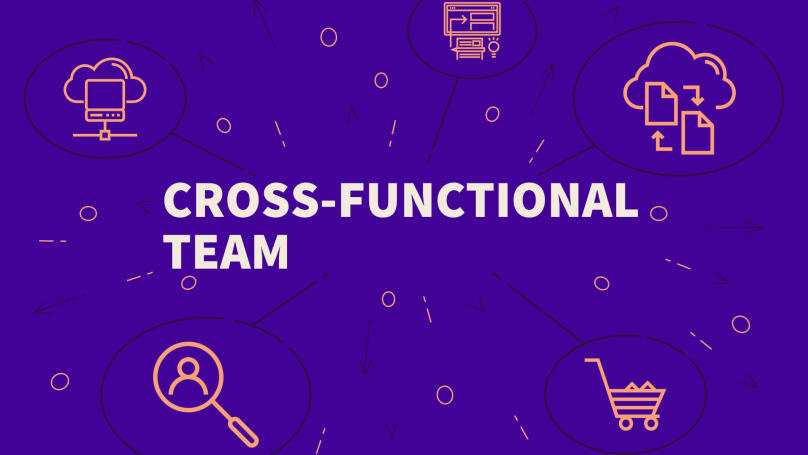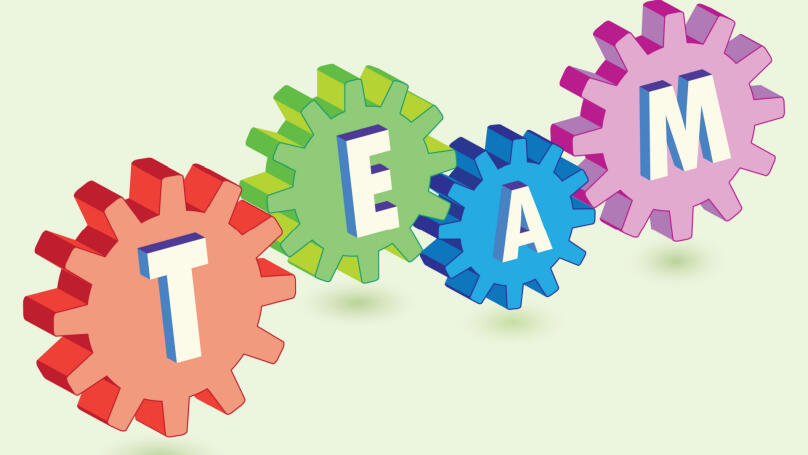Cross-functional team

What is a cross-functional team?
A cross-functional team is a working group of professionals from various company functional areas who possess the right skills to create and develop a product independently, without additional assistance or help from other teams. In other words, cross-functionality means a group of employees with various expertise and experience working together to achieve a common goal. The name is derived from the Scrum methodology - a flexible system, a unique framework for developing and managing projects, and a team approach for alternative ways to distribute team tasks.
Therefore, representatives from several company departments should be in a cross-functional team. For example, more than just requiring technical specialists to develop and launch a new gaming application, you will also need UX designers, illustrators, marketers, copywriters, promotion specialists, etc. This allows you to organise the work within a team and not transfer the project from one person to another. The major difference between a cross-functional team and a more traditional one is the independence of other departments and specialists. Whilst traditional teams involve a clear hierarchical structure and employees are employed in their intended departments, cross-functional teams go beyond these limits. Employees from different company departments come together to solve a particular problem.
Types of cross-functional teams
Cross-functional teams work differently in various organisations and businesses. In contrast, startups are small enterprises with departments containing a few dozen employees. They often have specialised teams, including employees with different fields of expertise.
Larger companies purposefully create cross-functional teams. The teams may differ depending on the tasks they need to complete.
-
Project Teams. The teams are formed directly for developing and implementing a particular project; therefore, team members must possess the expertise and experience necessary to achieve this aim.
-
Product Teams. They work on creating a new product, its development and any additional management. They employ experts in development, design, marketing, and technical support.
-
Management Teams. They consist of managers and executives of varying levels of experience for coordinating strategic decisions and making managerial decisions.
-
Innovation Teams. These teams are formed to create new ideas, research, and develop innovative products.
-
Process Improvement Teams. These teams work on improving business procedures and perfecting operating efficiency.
Cross-functional teams can also be categorised based on how their working members interact.
-
Decentralised Teams, whose members make decisions and do not need to be supervised and approved by the head of the company.
-
Temporary Teams are created to solve a specific problem; their work is limited by time, and their result is evaluated exclusively by solving the problem or completing the job.
-
Virtual Teams. These teams work remotely using modern technologies and communication for collaboration, enabling you to bring together professionals worldwide without having to be physically present.
Roles and responsibilities in a cross-functional team

The structure of the cross-functional team, namely the number of employees, their knowledge, existing skills, experience, and competencies, should be based on which task needs to be solved. Determine what knowledge and skills are necessary to achieve this, what employee's experience will benefit the work, and who is more interested in effectively solving a particular issue.
However, in any case, in cross-functional teams, it is essential to have professionals who will assume the following roles:
-
Team Leader. They are responsible for the overall management of the team, the coordination of its activities, decision-making, and achieving the final result. Likewise, a team leader's responsibility includes ensuring effective communication and maintaining the right working atmosphere. They must also be prepared to delegate authority, hold other team members accountable, motivate them, and provide all possible assistance in their activities.
-
Representative of different functional areas. They should be experts in their field and represent the interests of this area in the team. Representatives must also pass on any necessary information and knowledge.
-
Project Manager. They are responsible for planning and managing the project and all available resources, distributing tasks, and coordinating work between various team members and representatives of functional areas.
-
Analyst. They gather and analyse data, research, identify problems, and recommend solutions. The analyst also observes and assesses the team's intermediate results.
-
Innovator. The team member who is known as an innovator must inspire the development of ideas and create innovative solutions. They seek opportunities for improvement and development and provide new solutions to problems as well as creative work techniques.
Therefore, the role of each member of a cross-functional team has its own characteristics. Still, all of them are aimed at effective work and promptly achieving the set goals.
Benefits of cross-functional teams
Because a cross-functional team surpasses traditional project management principles, it has numerous advantages:
-
Has an absence of a hierarchical structure and streamlines the bureaucratic process. Team members collaborate on the outcome and do not wait for answers or approval from other departments; everything is limited to getting confirmation from the team leader.
-
A wide range of knowledge and experience. This contributes to a high-quality and comprehensive examination of an issue and then solving the problem.
-
Adaptability and flexibility of activities. A cross-functional team can quickly adapt to changing market conditions for the final product and obligations. They can rapidly respond to any changes, difficulties, and unforeseen problems.
-
Productivity and a high speed of development. Cross-functional teams solve problems more effectively due to having diverse skills and experience. This allows for a more detailed and comprehensive assessment of the situation, making complex decisions and achieving goals.
-
Innovation. Teams with different functions can actively develop new ideas and utilise innovative approaches to work. Interaction between various experts stimulates creative thinking and contributes to creating new techniques.
-
Rapid product launch. Working together on a single product allows it to reach the market faster, and you can start making a profit.
To fully achieve these benefits, ensuring effective project management and that the team members fulfil their responsibilities and cross-functional duties is necessary.
Disadvantages of cross-functional teams

However, despite many advantages, cross-functional teams still have drawbacks. Amongst them are:
-
Difficulty in coordination. Cross-functional teams involve experts from different areas, resulting in difficulties in coordinating and organising activities. This is influenced by different approaches to work, priorities, and communication languages, which makes it challenging to communicate effectively.
-
Risk of conflict. The likelihood of tense relationships and conflicts in the team increases significantly due to different approaches and views between representatives of functional areas. Resolving these situations and maintaining a healthy psychological climate requires additional effort, resources, and time.
-
Pressure. Managers of companies that develop temporary cross-functional teams need quick results from their members. At the same time, they must be achieved in a relatively short period. Therefore, employees face increased workload and pressure.
-
Overblown expectations. Cross-functional teams are often expected to overperform and get results. However, it is important to acknowledge that cross-functional team members are not a group of superheroes who make the impossible possible.
Furthermore, the listed disadvantages above do not eliminate all cross-functional teams' advantages. They only clarify that building this kind of working group and maintaining its work is a complex and labour-intensive process that requires control and supervision to attain maximum results.
Examples of cross-functional teams
Google often employs cross-functional teams to develop and launch new products. These teams collaborate with developers, programmers, designers, marketers, and other experts to ensure the product is as user-friendly as possible and popular with customers.
The American company Tesla utilises a cross-functional team model for the pioneering development and production of its electric cars. They collaborate with designers, engineers, and production specialists to achieve high-quality standards.
Consumer product manufacturer Procter & Gamble utilises cross-functional teams to create new products. They develop working groups consisting of direct product manufacturers, market analysts, and marketers to discover new creative solutions.
The Spotify platform has also shifted to creating cross-functional teams to enhance the music platform, including its interface and design.
How do you build a cross-functional team?

Building and developing an effective cross-functional team involves several key stages:
Stage 1. Defining your goal
Before assembling a team, you must have a good idea of the main task you want to solve. This could be, for example, developing a new product, establishing a long-term development strategy, examining the market and prospects, etc. Furthermore, you set the skills required to solve the main issue and all additional intermediate tasks. The team's specialists are picked according to the purpose of building a cross-functional team and the skills required.
Stage 2. Building the team's structure
At this point, ensuring the diversity of specialists and the skills required for cross-functional teams is vital. Additionally, expanding the diversity beyond experience and expertise would be ideal. It could be age diversity, status, background, nationality, viewpoints, etc. Remember that the more diverse the team members are, the more effective and productive they will be.
Stage 3. Deciding on your team leader
The team can only function effectively with a leader. For this role, you must find a competent manager or head of one of the departments who is familiar with most of the other team members, if not all of them. They must unite people with different views and beliefs into a coherent team.
Stage 4. Assigning the remaining roles
Besides the leader, there are other cross-functional roles in the team. Even at the team building stage, you must know which specialist you want to offer a particular position to. Before working on a cross-functional team, remember to base your team on employees' competencies, skills, and responsibilities. For example, if an employee is a good manager, they should be given the role of project manager.
Stage 5. Outlining the team rules
Assigning each team member a certain level of responsibility, duties, and authority is essential at this stage. In addition, establish common rules for cooperation and interaction for everyone. For example, it is crucial to outline the basic rules for a cross-functional team - to communicate with all team members, suggest the most daring ideas, not interrupt others, and make all decisions together.
Stage 6. Maintaining work and communication
This stage involves maintaining close contact, creating a common chat room for all team members, and following all established rules to achieve effective cooperation. The leader must also maintain a healthy working environment, motivate employees, support them, and resolve conflicts. It is essential not to attempt to avoid disputes that will arise during any discussion but to learn how to resolve them and reach compromises effectively.
At this stage, it is necessary to evaluate intermediate performance results, assess the performance of employees, plan further steps and monitor the team's progress, adjusting key processes if required.
Conclusion
Cross-functional teams are becoming increasingly popular and sought-after within project management. Although creating this kind of working group is a challenging and time-consuming process, its advantages and high performance enable it to remain a successful and relevant approach in the market. The main purpose of team building is to take responsibility for teamwork and not disregard the teamwork rules! In this case, cross-functional teams will also increase the company's efficiency.























